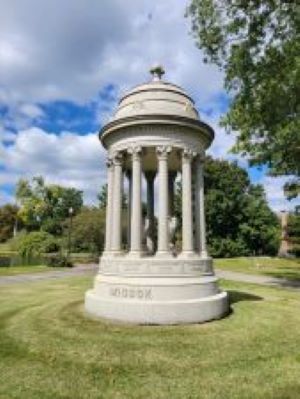Although he was 63 years old, when the Civil War broke out, Daniel McCook, a practicing lawyer and one of the original Fighting McCooks, volunteered his services to the Union. He was commissioned as a major. When Confederate troops went through southern Ohio during Morgan’s Raid, Major McCook joined in the advance of the Union pursuit. This was the genesis of their contribution and chronicle in veterans who made an impact – the McCook Family.
On July 19, 1863, Federal troops attacked at Buffington Island, where the Confederates were planning to cross the Ohio River back into Western Virginia. McCook was shot and mortally wounded. He died two days later. He was laid to rest at Spring Grove Cemetery in Cincinnati, along with many of his sons, who also fought during the war.
The Fighting McCooks
Daniel and his brother John were the patriarchs of the Fighting McCooks. The two brothers along with 13 of their sons all fought in the Civil War making the family one of the most prolific in American military history. Daniel’s son Robert McCook left the security of his successful law practice at the start of the war to recruit and train the 9th Ohio Volunteer Infantry Regiment.
During the Battle of Mill Springs, Colonel McCook was shot in his leg. After a short recovery period, he returned to active duty and was promoted. Near Selma, Alabama, McCook’s party was attacked. He was shot in the stomach and died the next day at the age of 34. He was also laid to rest at Spring Grove.
Roberts brothers who also fought include Major Dr. Latimer A. McCook who fought in the 31st Illinois Infantry. He was wounded at Vicksburg and again during Sherman’s March to the Sea and died of complications from his wounds.
Colonel George Wythe McCook joined the 157th Ohio Infantry he was an Ohio Attorney General and was candidate for Governor of Ohio.
Representing privates through the rank of major general
Major General Alexander McDowell McCook started the war in the 1st Ohio Infantry. He saw action at the Battle of Bull Run. He was promoted and commanded a brigade in Kentucky. He saw action in several battles. At the end of the war, he was given command of the District of Eastern Arkansas.
Daniel McCook, Jr. was a brigadier general and was killed in action at Kennesaw Mountain
Colonel Edwin Stanton McCook was a Union Colonel during the war. He graduated from the United States Naval Academy in Annapolis and joined the 31st Illinois infantry. He saw action during several battles and was wounded three separate times during the war but survived. He became Governor of the Dakota Territory and was assassinated in office.
Charles Morris McCook was a private in the 2nd Ohio Infantry. He was killed in action at the First Battle of Bull Run and died in his father’s arms.
The Youngest McCook to serve was 15 years old
John James McCook was a captain during the war and was the youngest member of the McCook family to serve, joining at the age of 15. He was wounded during the battle of Spotsylvania and never returned to duty. After the war he became a New York attorney and railroad executive.
The Daniel McCook House in Carrollton, Ohio, is preserved as a museum. McCook Field, the experimental station of the Aviation Section, located in Dayton, was named for the McCooks. It was operated from 1917 to 1927 before it was moved north to a larger facility at Wilbur Wright Field, that later became Wright-Patterson Air Force Base.
Dodds Memorials is proud to have contributed to the memorialization of the Fighting McCooks. It is experiences like this that uniquely positions us to assist with veteran memorialization projects.

